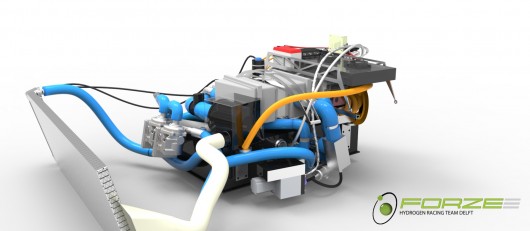Forze team unveils new hydrogen-powered racer
February 26, 2013

At peak power the VI generates 190 kW (260 hp) enough to accelerate from 0-100 kph (62 mph) in under 4.0 seconds.
On the right side of the racing fence you have your combustion engine. Politically incorrect to some but a highly efficient piece of engineering design that transported millions for the past hundred years and kept Beijing smoggy since 2008. On the left side of the power debate, you have your battery-electric options. Heavy, costly and slightly dangerous, this mode is still in its evolutionary infancy but is making headway against its dinosaur brethren.
But what about the centrist hydrogen party? The experimentation with hydrogen as an alternate fuel source is not new. In select urban centers, public transit systems have been using the "H" for years now, but on the race track, not so much. This is where Forze Hydrogen Racing Team Delft is stepping in to make the case for hydrogen power.
Following up on last year’s racing foray with the first hydrogen-powered car to take on petrol-burning competitors, the Forze team from The Netherlands’ Delft University of Technology has now gone on to bigger and better things. Its new racer the Forze VI, delivers what the teams deems "super car-ish performance." Not only does it look like a serious racer the new model contains six times the power of last years’ car.
Racing a larger, faster car Team Forze aims to "shock and revolutionize the race world.” At peak power the VI generates 190 kW (260 hp) enough to accelerate from 0-100 kph (62 mph) in under 4.0 seconds. Developed by Forze, the fuel cell system generates 100 kW of power inside Forze’s proprietary fuel cell system. And because the car is powered by a fuel cell system, the only thing coming out the back end is water – making it the ideal car for your next desert-centric vacation.
Two electric motors power the rear wheels independently; as a result a special type of electric differential had to be used. This configuration is expected to reduce lap times against the more traditional drivetrain setups. The system is also designed to be symbiotic in its sharing of regenerative and cooling abilities. For example, heat generated by the brakes is stored and used to recharge the system as needed, nothing new, except water produced by the fuel cell is then used to cool the brakes. Ah ha! And as we know, cooler brakes equates to more effective braking and the ability to hit brake points later, which in turn allows for more time on the go-pedal, therefortowhit this should equates to faster lap times.
This summer the VI is set to race against traditional fire-powered cars in the Caterham Cup. The team is also expected to put the new racer through its paces on Germany’s Nürburgring Nordschleife. The green racer will try to break the lap record for hydrogen powered vehicles on the dreaded green ring of heck, all the while leaving nothing but traces of water in its wake.
Source: Forze Delft
Copyright © gizmag 2003 - 2013 To subscribe or visit go to: http://www.gizmag.com
